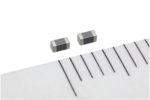Menlo Microsystems, Inc. announced the production release of the MM5130, the first high-performance RF switch manufactured with their proprietary Ideal Switch technology. The MM5130 is designed to handle 25W with ultra-low losses, in a miniaturized wafer-level chip-scale-package (WL-CSP). Historically, this level of performance has been reserved for large RF mechanical relays, which have major drawbacks. […]
filters
Automotive noise suppression filters work in MF and HF bands
TDK Corporation announces that it has developed the MHF1608 series of HF band noise suppression filters for automobiles, and will begin mass production in September 2020. The noise suppression component will be inserted in signal lines for electronic control circuits in automotive applications including car audio, navigation, and battery monitoring systems. Signal transmission paths are […]


